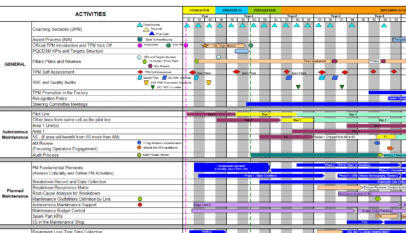PROJECT MANAGEMENT – Step 3: PLANNING
- Kick-off Meeting
- Work Plan & Responsibilities
- Risk Analysis (Risk Scan, Management Plan)
PROJECT MANAGEMENT – Step 3: PLANNING – Kick Off Meeting
OBJECTIVES:
- Ensure Everyone has a Full Understanding of:
- Project Scope
- Project Objectives
- Roles & Responsibilities
- Develop a Practical, Detailed Work Plan
- Create Ownership of the project on the part of all participants
- Introduce Tools to Manage and Control the Project
PARTICIPANTS: – Extended Team
- Project Team
- Representatives of Sub-Teams
- Ad hoc team members whose work significantly impacts the plan
PROJECT MANAGEMENT – Step 3: PLANNING – Work Plan Definition
- Work Plan – Detailed plan of the tasks, scheduling and responsibilities required to carry out a project
- “Work Breakdown Structure (WBS)”
- A task oriented detailed breakdown, which defines the work packages (“buckets”) and tasks.
- Forms the basis for time scheduling, and work responsibility
- Dependencies
- Start & End Dates; Duration
- “Work Breakdown Structure (WBS)”
- Responsibilities
PROJECT MANAGEMENT – Step 3: PLANNING – Developing the Work Plan Definitions: “Hierarchy” & “Sequence”
- Hierarchy – Levels within the Work Breakdown Structure:
- Level 1 = Top Level or PHASE; The “How”;
- Levels 2, 3 and below = Activities / Tasks required to complete the Level 1 (or Phases of the project)
- Level 1 = Top Level or PHASE; The “How”;
- Sequence – Relative order in which the activities must be performed.
(understanding that there will be simultaneous activities going on in the various levels)
PROJECT MANAGEMENT – Step 3: PLANNING – Developing the Work Plan Hierarchy Diagram

PROJECT MANAGEMENT – Step 3: PLANNING – Developing the Work Plan Definition: “Assumptions”
- Assumptions –
- Statement agreed by the team as taken for granted or truth
- Useful for “putting a stake in the ground” around which to build a timeline when there are numerous unknowns.
- Can cover Time, Cost, Performance, Scope
- Often necessary in order to develop initial timeline
PROJECT MANAGEMENT – Step 3: PLANNING – Developing the Work Plan Assumptions List – Example

PROJECT MANAGEMENT – Step 3: PLANNING – Developing the Work Plan Procedure
- Top-Down, Bottom-Up
- Pre-Kick Off:
- Project Team develops the Top Level Work Plan (Level 1) using a Top-Down approach
- Project Team validates Milestone Dates
- For Innovation Projects, Sub-Teams draft detail plan
- Kick Off (Extended Team):
- For Non-Innovation Projects, extended Team develops detail levels of the Work Breakdown Structure in a Bottom-Up approach, using the Affinity Process
- Full Work Breakdown is validated by a Top-Down review by the Extended Team
- Sub-teams add Start/End Dates and Responsibilities
- Pre-Kick Off:
PROJECT MANAGEMENT – Step 3: PLANNING – Developing the Work Plan The AFFINITY Process
- Brainstorm all Tasks
- Group the Tasks
- Create Hierarchy (Completeness Test)
- Create the Sequence
PROJECT MANAGEMENT – Step 3: PLANNING – Developing the Work Plan Affinity Process – Brainstorm Tasks

PROJECT MANAGEMENT – Step 3: PLANNING – Developing the Work Plan Affinity Process – Group Like Tasks

PROJECT MANAGEMENT – Step 3: PLANNING – Developing the Work Plan Affinity Process – Create the Hierarchy


PROJECT MANAGEMENT – Step 3: PLANNING – Developing the Work Plan Affinity Process – Create the Sequence

PROJECT MANAGEMENT – Step 3: PLANNING – Developing the Work Plan Level of Detail?
- How much detail?
- When the task name has a discrete meaning to the one who will implement it.
- Can clearly identify resources and timing for each task.
- To sufficient detail where the project (or your piece of it) can be controlled.
EXERCISE 4
Lower Level Work Breakdown Structure
Remember: VERB + NOUN
PROJECT MANAGEMENT – Step 3: PLANNING – Developing the Work Plan Definition: “Dependency”
- Dependency
- A relation between activities, such that one requires input from the other.
- E. g. A task or group of tasks cannot begin until preceding work (Predecessors) has been done, thus the word ‘dependent’ or ‘dependency’.
PROJECT MANAGEMENT – Step 3: PLANNING – Developing the Work Plan Dependencies: 4 Types
We rarely get into the detail of dependencies in less technical projects. Still, it is good to understand the types of dependencies and how dependencies are used in developed detailed Work Plans.
There are four types of Dependencies… (review slide)
NOTE: Start-to-Finish is rarely used.

PROJECT MANAGEMENT – Step 3: PLANNING – Developing the Work Plan Definition: “Network Diagram”
- A schematic of the logical relationships of project activities.
- Always drawn from left to right to reflect project chronology.
- Main purpose is to define dependencies vs concurrent activities.
- Use one work level below the WBS level at which you want to build dependency links. (Independent of higher levels)
PROJECT MANAGEMENT – Step 3: PLANNING – Developing the Work Plan The Network Diagram – Example
This method has been applied to the Innovation process, which we will look at when talking about Project Control.

PROJECT MANAGEMENT – Step 3: PLANNING – Developing the Work Plan Definition: Critical Path
- Critical Path
- The series of tasks that must finish on time for the entire project to finish on schedule.
- The path (sequence) of activities which has the least amount of scheduling flexibility (the least amount of float).
- Represents the longest total time required to complete the project.
- A delay in any activity in the critical path causes a delay in the completion of the project.
PROJECT MANAGEMENT – Step 3: PLANNING – Developing the Work Plan Dates and Responsibilities
- Dates
- Start with Milestone Dates and/or Phase Dates (Assume these to be valid)
- Tip – It is often helpful to work backwards first and fill in critical dates to meet Milestones, then go forwards and fill in remaining dates
- Use the Assumptions Tool
- Responsibilities
- Wherever possible, use individual names
- Where names are not known, use departments/functions
PROJECT MANAGEMENT – Step 3: PLANNING – Developing the Work Plan Elements of a Successful Project Plan
- Content
- Enough detail to make it meaningful and usable
- Not so much detail that it becomes unnecessarily complicated
- Clear and unambiguous
- Understandability
- Easily understood by all who use it
- Changeability
- Can be easily updated, changed and revised
- Usability
- Easily used to monitor project progress
- Means of communication
PROJECT MANAGEMENT – Step 3: PLANNING – Risk
- “A ship in harbour is safe, but that’s not what ships are built for.” William Shedd
- “What we anticipate seldom occurs. What we least expect generally happens.” Disreali

PROJECT MANAGEMENT – Step 3: PLANNING – Risk Analysis
Risk: The probability of loss through the occurrence of an undesired event
- Evaluating Risks:
- What is the probability of occurrence?
- What is the impact of the consequences?
- Managing Risks
- Reduce the probability or impact of occurrence
- Increase the probability of detection before loss occurs
PROJECT MANAGEMENT – Step 3: PLANNING – Risk Analysis Risk Categories
- Project Risks
- Product Liability Risks
- Technical Risks
- Business Risks
- Personnel Risks
- Natural Risks
PROJECT MANAGEMENT – Step 3: PLANNING – Risk Analysis Steps in Developing a Management Plan
- Step 1: Identify potential risks
- Innovation: Risk Quick Scan
- Non-Innovation: Potential Risk List captured at Kick Off
- Step 2: Develop Risk Management Plan
- Evaluate Risk List (or RQS results)
- Determine the appropriate response
- Document on the Risk Management Plan
PROJECT MANAGEMENT – Step 3: PLANNING – Risk Management Plan: Responses to Risk
There are four possible responses to any risk:
- Retain the risk – this would apply to those risks in the lower left hand quadrant (low probability, low impact)
- Avoid the risk – To do this, your response need to either decrease the probability of occurrence to 0, or increase the probability of detection to 100%.
- Reduce the Risk – Most responses will fall into this category. You can either :
- find a way to reduce the probability that it will occur (Allow appropriate time in the timeline for capability trials prior to launch production)
- reduce the impact that the failure will have should it occur (Reduce a launch from a national launch to a test market launch)
- increase the probability that you will detect the failure before it has an effect. (Positive release for maiden production runs)
- Transfer the Risk – an example of this would be to transfer risk onto a 3rd party (e.g. ensure that raw material supplier has responsibility for quality / safety of materials purchased)

PROJECT MANAGEMENT – Step 3: PLANNING – Risk Analysis Risk Matrix

PROJECT MANAGEMENT – Step 3: PLANNING – Risk Management Plan Completing” the Plan
We probably all know of live examples of issues being raised in Risk Analysis sessions and no actions assigned… OR actions assigned, something changes, and there is no follow-up with the Risk Plan, AND failure occurs (“I had a feeling that was going to happen…”)

Decide on action plans
WHO does WHAT by WHEN
The plan must be dynamic… Follow Up !!
“No plan survives contact with the enemy.”
(WWII Soldier)
EXERCISE 5
- Identify 5 potential risks of the project
- Indicate Probability & Impact
- Categorize as High, Medium, or Low
- Identify Contingency Plan


















